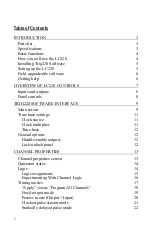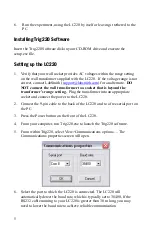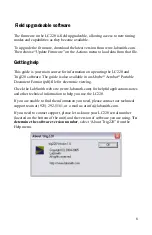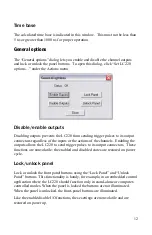
4
range 0.0 – 0.2 V are TTL “lows.” Intermediate voltages should not be present
on inputs and outputs except during transitions. The inputs and outputs are
protected against connection to 115 VAC. When disconnected the inputs are
read as TTL “highs.”
The LC220 can be connected to/ disconnected from the PC at any time without
damage to either unit. This ability allows you to program to LC220 at your
computer, then to take the unit to the experiment area for stand-alone use.
Basic functions
The LC220 provides two functional
channels
, or internal signal paths.
At any time, each channel can be assigned one of eight
timing modes
. Timing
modes include clocks, counters, delayed triggers, etc. You can set various
properties
for each timing mode—for example, the delay length on a Delayed
Trigger. All modes are aligned to a time base derived from an internal or
external clock, allowing resolution down to 5 ns.
Each channel
also includes
logic
settings which specify the conditions that will
trigger the channel. A channel can be triggered by logical combinations of
signals from the inputs and/or the output of the other channel.
All settings and setting profiles for a particular experiment can be stored as an
experiment file
on your computer. Experiment files bear a .tr2 extension.
How you will use the LC220
In most cases, you’ll use the LC220 as follows:
1.
Using the Trig220 software, open an existing experiment file, or create a
new file.
2.
In Trig220 (or LabView), program the properties and logic for each
channel and for the experiment as a whole.
3.
Send the properties and logic to the LC220’s memory.
4.
Test your program by simulating triggers and examining the outputs using
the LC220’s channel LEDs and/or an oscilloscope or other diagnostic tool.
5.
Plug your experimental equipment to the LC220.






































